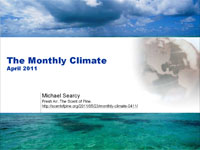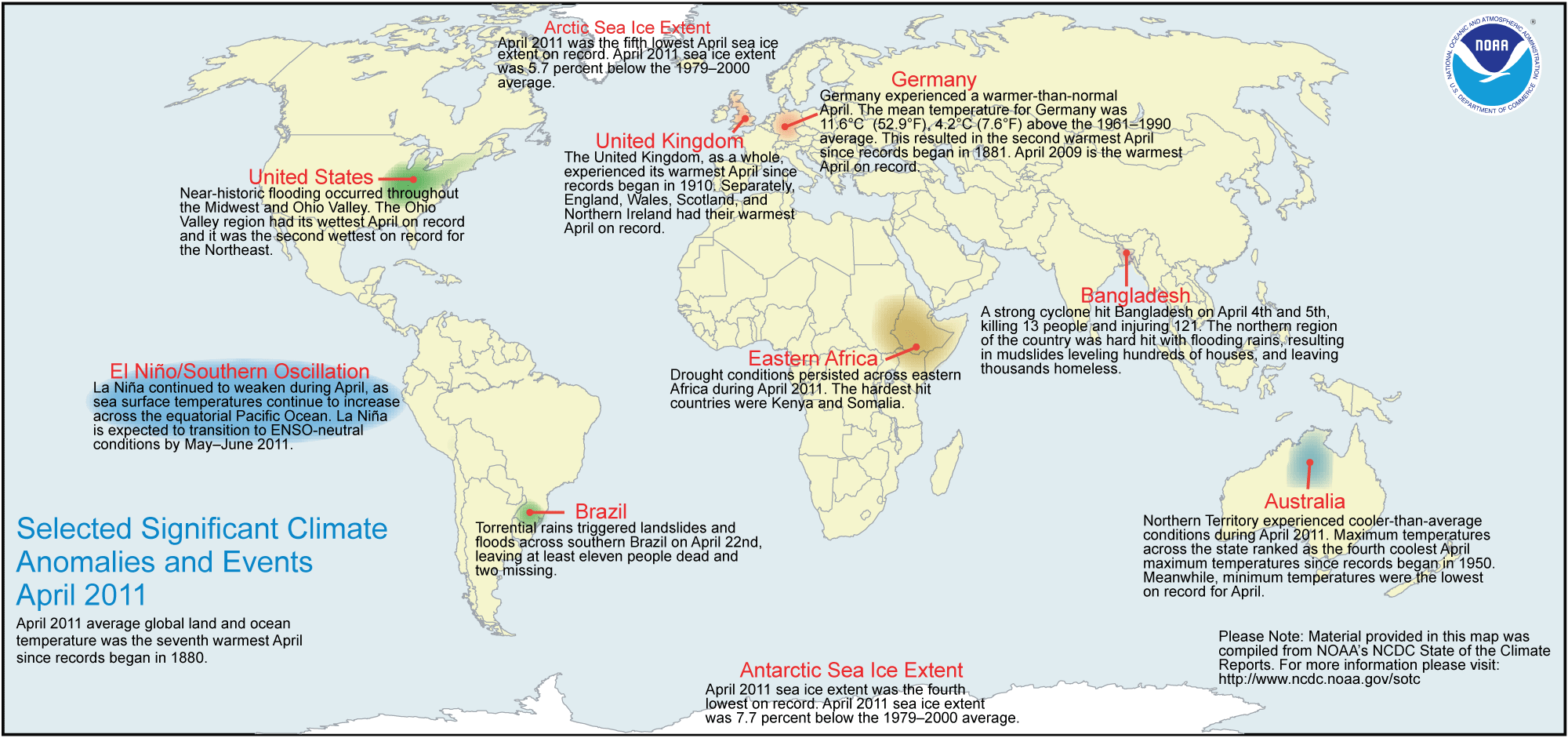Monthly Climate Summary: April 2011
Posted on 25 May 2011 by Michael Searcy
NOTE: Skeptical Science is going to begin re-posting the monthly climate summaries of Michael Searcy from Fresh Air. The Scent of Pine. This is his monthly climate summary for April 2011.
 Drought. Wildfires. Wind. Hail. Tornadoes. Flooding.
Drought. Wildfires. Wind. Hail. Tornadoes. Flooding.
April 2011 was a month defined by extreme weather conditions, particularly in the United States. Texas followed its driest March in over 100 years with its fifth driest April. Higher temperatures and absent rainfall were blamed for power outages at refineries, a spike in rabies reports, and wheat crop losses. By month’s end, 94% of the state was experiencing severe to exceptional drought conditions. The state has received a mere 1.68 inches of rain since February 1, easily besting its driest February-April period in history by nearly an inch. The deepening, months-long drought was accompanied by over 6,000 new wildfires that burned a record 1.79 million acres across the country during April and 2.2 million acres since January in Texas alone. The extreme conditions lead Texas governor Rick Perry to proclaim three days in April as “Days of Prayer for Rain”.

Six states experienced record setting precipitation while record drought continued in Texas. Image credit: NOAA
The month also witnessed violent storm fronts that brought record precipitation, severe wind, and hail the size of golf balls and larger. Illinois, Indiana, Ohio, Pennsylvania, Kentucky, and West Virginia all reported their wettest April in history. Kentucky received an average of 11.88 inches of precipitation — nearly three times its long-term average for the month — breaking the state’s previous record by more than four inches. Up to 20 inches of rain, nearly half the normal annual amount, fell in some areas resulting in record flooding in the Ohio valley, and the Red River in Minnesota reached major flood stage for the third straight spring. The previous one-day record for severe wind reports of 455 was broken twice during the month. The storms of April 19 generated 575 severe wind reports, but even that number paled in comparison to the staggering 1,318 preliminary severe wind reports resulting from the storms of April 4.
But it was the tornadoes of April that truly made history. The 30-year-average for April tornadoes nationwide is 135. The monthly record was 542.
The preliminary number of tornadoes reported in April 2011 is 875.
Single day events saw Wisconsin experience its largest monthly April tornado outbreak in history on April 9, and an EF-4 twister ripped a 21-mile path across the city of St. Louis on April 22. But it was the multi-day outbreaks that generated the most devastation. From April 14 to April 16, there were 329 preliminary tornado reports across 16 states with the final tally expected to be around 155, making it one of the largest outbreaks of any month in history. States of emergency were declared in Alabama, Mississippi, Oklahoma, and North Carolina. North Carolina bore the brunt with at least 30 confirmed tornadoes destroying hundreds of homes and businesses and resulting in at least 24 deaths, marking the three days as the largest tornado outbreak to ever hit the state, and the second deadliest outbreak on record for North Carolina.
April 25th through the 28th saw another massive amount of tornadic activity. An estimated 305 tornadoes hit from Texas to New York during the 4-day period, with 190 of them touching down over just 24 hours on the 27th and 28th. The outbreak included three EF-5, 12 EF-4, and 21 EF-3 tornadoes and killed nearly 350 people, mostly in the state of Alabama, making it the deadliest tornado outbreak since 1936. A strong EF-4 tornado packing winds of 190 mph devastated the cities of Tuscaloosa and Birmingham. This single cyclone tore a path as much as 1.5 miles wide and was on the ground for more than 80 miles causing an estimated 65 fatalities and over a thousand injuries.
Allstate, the nation’s largest publicly held personal lines insurer, announced $1.4 billion in estimated catastrophe losses for the month with over 100,000 claims reported to date in the affected areas. Risk-modeling company AIR Worldwide estimated the tornadoes caused $3.7 billion to $5.5 billion in insured losses industrywide. The years 2008 through 2010 were already the industry’s costliest for thunderstorm damage—which includes hail, tornadoes and other severe storms—with a total tab of $30 billion, said Robert Hartwig, president of trade group Insurance Information Institute, via a Wall Street Journal report, but 2011 is on track to exceed any of those three.
Meanwhile, half way around the world, Thailand experienced massive flooding that impacted nearly a million people. In what is normally the dry season, some areas received more than 50 inches of rain bringing mudslides and widespread damage to crops.
Observational research from the scientific community continued to explore the ongoing reaction of natural environments and processes to changing conditions. Under a warming climate, Antarctica is becoming greener as grasses are finding better conditions under which to take root while warming waters and declining krill populations are resulting in declining penguin populations. An analysis of glaciers in the southern half of South America finds them melting at the fastest pace in the last 350 years. And earlier spring blooms are impacting the timing of ecological cycles while changes in rainfall patterns are influencing the migratory habits of some bird species.

USFS: Heavily deforested coastal mangroves are immense carbon stores. Image credit: Theo Allofs/Corbis
Separate studies focused on different global carbon sinks with researchers at Duke University concluding an 18-year study and finding the growth and seed-production abilities of several species of trees to be considerably more sensitive than previously thought to climatic changes such as earlier springs and summer droughts. The U.S. Forest Service found that coastal mangrove forests, which have been the targets of heavy deforestation, store more carbon than almost any other forest on Earth. And the longevity of underwater kelp forests was determined to be hindered by wave damage accompanying increased storm strength and frequency. Lastly, satellite data from NASA revealed lowered plant productivity in several of Earth’s larger ocean currents.
In the political arena, carbon pricing remained a contentious subject in Australia while the U.S. Supreme Court signaled a likely rejection of a lawsuit brought by six states attempting to limit greenhouse gas emissions by a myriad of power companies around the nation. The court indicated a preference for such regulations to be handed by the Environmental Protection Agency (EPA), an organization facing its own challenges.
The Republican party in the United States continued its multi-pronged attack on the EPA throughout the month. A bill aimed at blocking the EPA from using the Clean Air Act to regulate greenhouse gas emissions easily passed in the House of Representatives, but a companion bill failed in the U.S. Senate. And, in a budget deal compromise to avoid a government shutdown, the Republicans won significant environmental provisions that reduce the EPA’s budget by $1.6 billion, remove gray wolves in the northern Rockies from the endangered-species list, and defund the Interior Department’s Wild Lands initiative, which would have inventoried federal lands for their wilderness characteristics.
Meanwhile a study focusing on methane releases from hydraulic fracturing, an increasingly controversial process used in the drilling extraction of natural gas, found that such releases may contribute as much or more than coal to global warming. Natural gas has been gaining widespread favor amongst politicians in both parties in the U.S. considering its large natural stores in the country, relatively easy access, minimal regulation, and lower costs particularly when compared against rising oil prices.
Quotable
“Whereas, throughout our history, both as a state and as individuals, Texans have been strengthened, assured and lifted up through prayer; it seems right and fitting that the people of Texas should join together in prayer to humbly seek an end to this devastating drought and these dangerous wildfires”
- Rick Perry, Governor, State of Texas
Proclamation for Days of Prayer for Rain
April 21, 2011
Highlights
- News
- CNN: Fires tear across Texas
- Twister outbreak is 2nd deadliest in US history
- Tornadoes Blast Property Insurers
- Thailand Flooding Impacts Nearly One Million
- Cracked reactor leaking radioactive water
- Scientists: Arctic ozone depletion ‘unprecedented’
- Sea rising ‘at upper end of forecast’
- Rising seas scariest climate impact: Nauru’s Moses
- New York set to be big loser as sea levels rise
- Climate change to mean fewer cyclones and smaller waves, says CSIRO research
- Plant Strife: Satellite measurements show declining phytoplankton in ocean currents
- amednews: Editorial – Confronting health issues of climate change
- Risk of Malaria, Other Diseases May Rise With Global Temperatures as Climate Changes
- CSIRO boss backs carbon price
- House votes to kill EPA climate regulations
- Senate rejects efforts to block EPA climate regulations
- GOP Wins Deep Cuts in Environment Spending
- U.S. Supreme Court Signals Rejection of State Climate-Emissions Lawsuits
- No binding climate deal at Durban, warn US, EU
- Expert warns of reef climate change deadline
- U.S., China Energy Use Predicted to Flatten in Coming Decades
- Multitude of Species Face Climate Threat
- Climate ‘technical fix’ may yield warming, not cooling
- Reports
- Research
- Smithsonian scientists find declining rainfall is a major influence for migrating birds
- Duke Study Finds Trees More Sensitive to Climate Change
- Antarctica Growing Green With Grass
- Glaciers in Chile ‘melt at fastest rate in 350 years’
- Two of Earth’s Ocean Carbon Sinks Shrinking, Studies Show
- Mangroves Among the Most Carbon-Rich Forests in the Tropics
- Responses of wind erosion to climate-induced vegetation changes on the Colorado Plateau
- Arctic fresh water could affect Europe’s climate
- Plants’ earlier bloom times hurting some creatures
- Study: Gas from ‘fracking’ worse than coal on climate
- West Antarctic warming triggered by warmer sea surface in tropical Pacific
- Fewer penguins survive warming Antarctic climate
- National microalgae biofuel production potential and resource demand
- PLoS ONE: Climatic Factors Driving Invasion of the Tiger Mosquito into New Areas of Trentino, Northern Italy
- The economics (or lack thereof) of aerosol geoengineering
- The effects of boreal forest expansion on the summer Arctic frontal zone
- Changes in satellite-derived vegetation growth trend in temperate and boreal Eurasia from 1982 to 2006
- Climate change threatens European conservation areas
- Rings Reveal Extensive Yearly Climate Record
- Could a Leaking Ocean Current Keep Europe Toasty?































 Arguments
Arguments


































[DB] Hot-linked URL.
[DB] "The AMO is making a switch it seems"
Perhaps you mean the AO? The AMO is a 20-40 year oscillation; we have been in a warm phase since the mid-90s:
[Source]
The AO has been positive for several months now:
[Source]
It would reflect better on you to cite a source when venturing opinions on a science blog.
[DB] I would suggest learning a little time-series analysis. Using the EyecrometerTM does not give you appropriate context. What about the first 5 months of 2009 then? The AMO is a 20-40 YEAR oscillation. On a monthly basis, much variability/noise is present. All you can look at is if the monthly number is positive or negative and then all you can infer from that is "Hmm, interesting." All else is cherry-picking.
- It provides a context for other concurrent events
- It puts a relatable human perspective on impacts from severe weather events including fatalities, costs (direct and indirect), and disruptions to human processes (e.g., crop and livestock losses as a result of drought, shipping closures on the Mississippi as a result of flooding, etc.)
- It provides a compact historical record of anomalous weather events within the frame of a warming world.
While you may disagree, I think all of these items make such summaries worthwhile.